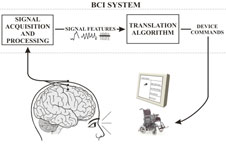
(Credits: modified from Jonathan Wolpaw et al., Clinical Neurophysiology 113:767-791, 2002; head image from BrainConnection)
For the past 20 years, a team of researchers led by Dr. Jonathan Wolpaw at the Wadsworth Center of the New York State Department of Health in Albany has been developing a BCI system based on scalp-recorded electroencephalography (EEG or brain-wave) activity. They have now produced a BCI system suitable for independent home use. This system is nearing the final stages of development and testing. Currently, a limited number of severely disabled individuals are using this technology at home to communicate.
People with ALS gradually lose the ability to use their muscles and therefore gradually lose the ability to communicate by speaking, nodding, or even with eye movement. The Wadsworth BCI enables these paralyzed people to communicate through a computer interface using brain signals. The user wears a simple stretchable cap embedded with small flat metal electrodes (this cap is the standard EEG cap used in clinical settings). No surgery is needed.
The BCI system records the brain's electrical activity from the scalp as the user watches a computer screen that displays flashing items that correspond to the keys of a standard computer keyboard. By analyzing the brain's electrical activity, the BCI system determines which item(s) the user wishes to select. With this system, the user can perform word-processing, write emails, operate an environmental control or entertainment interface, or use any Windows-based program that can be used with a keyboard. After the system is initialized by a caretaker or family member, the user can operate the system independently for up to eight hours per day. The BCI system requires oversight by a team of experienced BCI professionals who make periodic home visits and who monitor the home BCI systems by remote transmission of data to a central laboratory. This need for technical support contributes substantially to the cost of providing the service. Current research is aimed at reducing the need for ongoing technical support.
As part of the Wadsworth Lab's BCI research program, a small number of people with ALS who are almost completely paralyzed and who cannot use conventional assistive communication devices are currently using the Wadsworth BCI in their homes for communication with family and caregivers, for email, and for word processing.